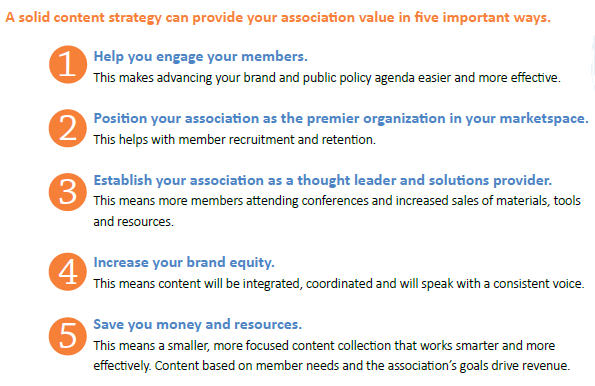 Over 100,000 associations in the U.S. today cover virtually every profession and industry but they face remarkably similar issues. We call them the 3 R’s.
Over 100,000 associations in the U.S. today cover virtually every profession and industry but they face remarkably similar issues. We call them the 3 R’s.

Regardless of their specific mission, each member of the executive leadership team grapples with the same challenges:
- Growing the member base
- Providing members value they can’t garner elsewhere
- Growing non-dues revenue through conferences, content, education products and services
A content-based marketing strategy has become the answer to solving these problems for many forward-thinking associations. What exactly is a content marketing approach? In a nutshell, it is a systematized process that allows associations to audit their marketing functions to determine if they allocating publishing, communication and marketing budget dollars effectively. This audit process often results in redirecting both human resources and capital to better serve members and drive revenue growth.
The eBook Taming the Content Vortex provides a roadmap to help associations determine which activities should be stopped, started or accelerated. A key first step is research and discovery, not only of what the association currently does but of the hot topics and pressing issues that members will likely face in the future. Too often, small subsets of association members wield an extraordinary amount of influence over what content assets (i.e., publications, research abstracts, magazines, newsletters, etc.) are produced. Unless there is an objective assessment as to whether or not these assets meet the majority of members’ needs—time and money could be wasted.

In our work with associations, it was often not clear just how many people were developing content, on what topics, on what schedule and for what purpose. A single version of truth was missing. Without a content strategy, your association likely has both duplication of effort and investment in content, and vehicles that don’t deliver value. Just imagine how much time and energy you could save if your association could eliminate one ineffective eNewsletter or series of marketing emails. It’s not just the resources to execute but the time it takes to plan, design, develop and distribute. In reality, not having a content strategy wastes time and money.
Most people agree that developing a content strategy can be overwhelming, and for associations it can appear to be even more difficult. There are so many inputs and perspectives to consider that at times you feel that you are in a whirlwind of unending demands. Content strategy takes some of the energy out of the vortex and allows you to slow down and ask some critical questions about what you are doing today and what you should be doing tomorrow.
If you are like most association managers, you care deeply about your mission and want your members to succeed. Yet the current content approach does not let you provide the best support and experience possible. By taking the time and energy to invest in your content strategy – even if you only do a pilot – you will see how resources can better be deployed to deliver less bulk and more quality more effectively. Perhaps the best outcome of implementing a content strategy is impacting the three R’s: retention, recruitment and revenue growth. An added bonus is clear direction for staff who want to deliver on the mission; the success of which is closely aligned with the value of the content published and shared by the organization.
To learn more about how associations are using content marketing strategy download Taming the Content Vortex.

Principal
Engaging your customers is at the heart of successful marketing programs. For more than 20 years, Cheryl has been building and executing content and thought leadership strategies designed to do just that. She is excited to be applying that well-honed skill to a help companies like Microsoft, Cisco, 3M, Intel, Capital One and Barclaycard tap into their stakeholder communities and build sophisticated content strategies.
Her experience base spans a range of industries – from technology and financial services to retail, travel, consumer products and healthcare. Cheryl has served as an integral member of her clients’ marketing teams, providing counsel on marketing and brand strategy, thought leadership, media relations, product introductions, and event management.
Prior to joining ComBlu, Cheryl spent 10 years leading corporate marketing for large, complex organizations.
